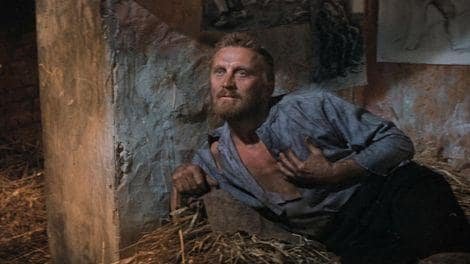Lust for Life (1956) | Movie Review

As a movie enthusiast, I have always had a soft spot for classic films that stand the test of time. One such movie that has always fascinated me is "Lust for Life," which stars Kirk Douglas as the legendary painter Vincent Van Gogh. Directed by Vincente Minnelli, this film offers a poignant portrayal of Van Gogh's life, struggles, and artistic vision.
Before delving into the details of the film, it is essential to understand the context and significance of Kirk Douglas's role. Douglas was one of Hollywood's most iconic actors, known for his rugged good looks, intense performances, and larger-than-life personality. In "Lust for Life," he plays Vincent Van Gogh, a troubled artist who struggled to find recognition and acceptance in his lifetime.
The film is based on the book of the same name by Irving Stone, which chronicles Van Gogh's life and artistic journey. It is not a biopic per se, but rather a poetic interpretation of his life and work. Minnelli's direction and Douglas's performance make this film a true work of art.
Vincent Van Gogh was a Dutch painter who lived in the late 19th century. He is now considered one of the greatest impressionist artists of all time, but during his lifetime, he experienced great difficulties to gain recognition for his work. He suffered from mental illness, poverty, and social ostracism, which made his life a constant strife.
"Lust for Life" explores Van Gogh's life from his early days as a struggling artist to his eventual suicide at the age of 37. The film depicts his relationship with his brother Theo, who supported him financially and emotionally throughout his life. It also shows his interactions with other artists, including Paul Gauguin and Emile Bernard, who were his friends and rivals.
Kirk Douglas's portrayal of Vincent Van Gogh is nothing short of extraordinary. He captures the artist's passion, intensity, and vulnerability with remarkable depth and nuance. Douglas's performance is so authentic that it is hard to separate the actor from the character. He portrays Van Gogh as a man driven by his artistic vision and tormented by his inner demons.
Douglas's physical transformation for the role is also impressive. He underwent extensive makeup and prosthetics to resemble Van Gogh's distinctive appearance, with his red hair, beard, and piercing blue eyes. His performance in "Lust for Life" earned him critical acclaim and cemented his status as one of Hollywood's most versatile actors.
Vincente Minnelli's direction and cinematography are some of the highlights of "Lust for Life." The film's stunning visuals and evocative imagery capture the essence of Van Gogh's art and life. Minnelli uses a palette of vibrant colors and bold brushstrokes to create a visual style that mirrors Van Gogh's artistic style. The film's use of light and shadow is also noteworthy. Minnelli captures the changing moods and emotions of the characters through the use of light and shadow. He also employs unconventional camera angles and movements to create a sense of visual dynamism and energy.
In addition to Kirk Douglas's remarkable performance, "Lust for Life" boasts an impressive supporting cast. Anthony Quinn plays Paul Gauguin, Van Gogh's friend and fellow artist, with whom he had a tumultuous relationship. Quinn's performance is intense and charismatic, and, whenever he is on screen, he brings a sense of danger and unpredictability to the character.
James Donald plays Theo Van Gogh, Vincent's loyal brother, who supports him through thick and thin. His performance is understated but powerful, conveying a sense of quiet strength and resilience.
One of the most significant themes of "Lust for Life" is Van Gogh's mental illness. The film "paints" (punt intended) his struggles with depression, anxiety, and hallucinations, which eventually led to his suicide. It also shows the stigma and ignorance surrounding mental illness in the late 19th century.
The film's portrayal of Van Gogh's mental illness is both poignant and accurate. It does not shy away from the harsh realities of his condition but instead portrays it with sensitivity and empathy. It also highlights the importance of mental health awareness and the need for compassion and understanding that those who suffer from mental illness deserve.
While "Lust for Life" is not a biopic in the strict sense, it is a relatively accurate portrayal of Van Gogh's life and work. Though the film draws on Irving Stone's book, which is based on Van Gogh's letters and other historical documents, it also takes some artistic liberties to create a more dramatic and emotional narrative.
However, the film's accuracy is not the most important aspect of its success. It is the emotional and artistic truth that it exudes, which makes it a timeless masterpiece. "Lust for Life" captures the essence of Van Gogh's art and life, and it does so with remarkable depth and sensitivity.
"Lust for Life" was a critical and commercial success when it was released in 1956. It earned several Academy Award nominations, including Best Actor for Kirk Douglas. The film's success also paved the way for other biopics and historical dramas, which became popular in the 1960s and 1970s.
Moreover, the movie inspired a new generation of artists and filmmakers, who were drawn to its poetic and emotional style. It has become a cultural touchstone and a classic example of Hollywood's Golden Age.
"Lust for Life" is a timeless masterpiece that showcases the best of Hollywood's Golden Age. Kirk Douglas's remarkable performance, Vincente Minnelli's direction and cinematography, and the film's emotional and artistic truth make it a classic that still resonates today. It is a tribute to the genius and tragedy of Vincent Van Gogh, and a testament to the power of art to transform and inspire.